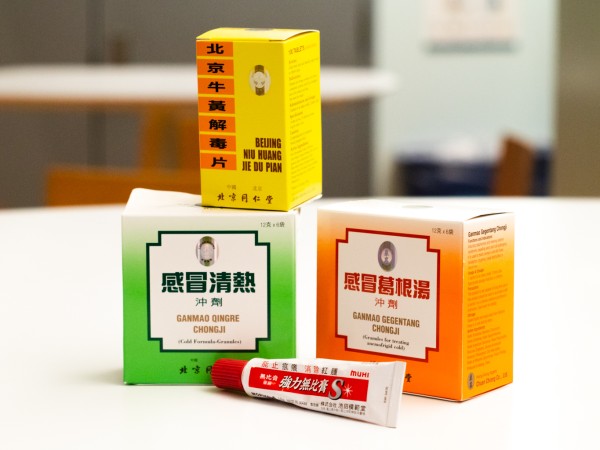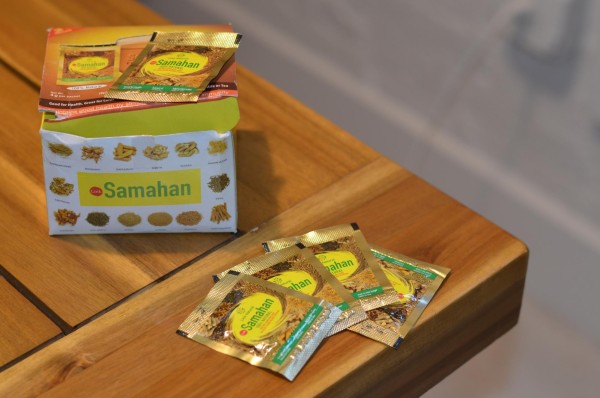Cough drops are flying off shelves and scarves are becoming a staple accessory: winter is approaching. Combined with our collective midterm stress, prioritizing our mental and physical health is extremely important yet getting harder to do.
While you might be looking to cure your freshman flu with the typical over-the-counter medications from your local CVS, some students are leaning into other forms of treatment learned from family histories. Many of these students approach healing as a unity between the mind, body and soul, including those bringing traditional healing practices from their family kitchens to their dorms and apartments.
Health as a balancing act: Traditional Chinese medicine

For CAS junior Andrew Zhang, traditional Chinese medicine was the go-to cure for his childhood ails. TCMs are sold exclusively by registered practitioners, which can be found at specific locations around the city.
“The results are more gradual than Western formulas, so it gives [the user] more control over the medicine’s effects,” Zhang said about various types of medicinal sachets.
One of his medicines, “感冒清热冲剂” (Ganmao Qingre Chongji) or cold-formula granules, are made from roots and leaves. The medicine is meant to be dissolved in hot water.
The mild nature of Chinese medicine led his mother to prescribe dosages instinctively: half a tablespoon of the powder during his younger years, then eventually one tablespoon as he got older. Whether it was to heal a sore throat, fever or runny nose, his mother turned to TCM as a universal remedy for cold symptoms.
The principle of balance is central to Chinese medicinal philosophy. For example, foods can possess opposing properties. Fried or spicy foods are considered warming, and raw produce or bitter herbs are considered cooling. Too much or too little of hot or cool foods are said to disrupt one’s bodily equilibrium.
Symptoms of illness can also be categorized into hot and cold, and they can be canceled out. A fever is a sign of excess heat, and chills are a sign of excess cold. A simple warming tea brewed with ginger and honey can alleviate mild cold symptoms.
But Zhang refers to TCM as a way of life beyond just physical health. He said that his mother kept this balance through her cooking.
“We could be eating Italian one night, but there would always be a standalone dish of steamed vegetables — sometimes kimchi — which, to a foreigner, wouldn’t make any sense. But this was how she made sure we ate a balance of hot and cold foods,” Zhang said.
For Chinese immigrants acclimating to American life, maintaining the rituals of TCM provides comfort in Western society.
“It feels more familiar for people,” Zhang said.
Nature’s Prescription: Southern medicinal practices
One misconception that people have about traditional medicine is that it requires an exhaustive knowledge of herbs, their quantities and their preparation methods. But Steinhardt sophomore Madison Smith said that this isn’t the case.
“The idea is that all nature is healing, unless it’s poisonous, of course,” said Smith. “Majority of the time, as long as you put any sorts of edible herbs together, it’s gonna do some good for your body,”
Growing up in Georgia, she says that her knowledge stems from the historical practices of Black communities in the rural South who couldn’t afford prescription medication. Smith’s herbal repertoire consists of an array of essential botanicals such as elderberries, mullein, fenugreek, licorice root, nettle, echinacea and yarrow.
In Smith’s family, herbal wisdom was passed down silently, more implicit than explicit.
“It was never really a sit-down conversation where we would talk about the best homemade herbal remedies to use,” Smith said. “It was just like a ‘if you know, you know’ kind of thing.”
Smith’s suburban upbringing felt like being at a crossroads of modern and traditional healthcare. While her grandparents tried to treat her with traditional home remedies, her parents would give her pills the doctor prescribed.
According to Smith, blending ingredients varies from person to person. Common ingredients, like ginger and lemon, may be used as a base while other ingredients mixed in varies by person — the true essence of traditional medicine lies in personalization. “Nothing is one-size-fits-all,” she said.
Unlike over-the-counter medicines that should only be ingested, herbs can be utilized in various ways from brewing teas to creating fragrances for households.
In Georgia, Smith would only spend $2 for an ounce of herbs that lasted years. Despite herbalism’s popularity in southern states, many of the core herbs aren’t locally sourced. Smith had to drive an hour from where she lived to a rural apothecary.
Now, in New York, Smith frequents local apothecaries and, when necessary, goes to online outlets. Smith often turns to what she calls her “miracle medicines,” available on Amazon from small businesses.
Smith’s go-to remedy is a rich amalgamation of elderberry, elderflower, marshmallow root and mullein, enhanced with lemon, honey, onion, garlic and a liquor base. The ideal preparation begins in the spring, so the mixture can mature until winter for optimal potency.
“There’s a certain peace in being fully aware of what I introduce to my body,” Smith said. “It’s simple: I see it, I know what it is, I put it in there and that’s it.”
More than just the body: Ayurvedic Medicine

Ayurveda is predominantly found in countries such as India and Nepal. Similarly to TCM, the concept of imbalance, or dosha, is paramount to Ayurvedic philosophy. Additionally, the philosophy centers on natural forms of healing by incorporating remedies made from spices, plants and herbs.
Having grown up in an Indian household, Stern junior and international student Anoushri Raheja knows these remedies by heart: a sandalwood and turmeric mixture for the skin, an aromatic oil for the hair, a fragrant tea for the gut. She remembers how when she got sick growing up, she was made to drink hot milk and turmeric.
“The underlying philosophy is to heal people naturally, to get rid of the imbalance,” Raheja said.
Raheja stores an assortment of Ayurvedic medicine in her bedroom — Samahan tea made from a medley of spices and Chyawanprash, a jam made of amla, an Indian gooseberry. Raheja said Chyawanprash was the medicine her mother claimed “would cure everything” from a stomach ache to a headache to a cough.
Some of the medicines are even good as quick refreshments.
“These are supposed to help with digestion,” Raheja said, referring to Bhavana Shunti, a tub of small ginger and honey gummies. “But my friends and I just eat them as snacks.”
The Ayurvedic healing processes are multi-dimensional. Besides the physical body, the mental self and personality of an individual are just as important to Ayurvedic philosophy, Raheja said.
“I was raised to understand that Ayurveda is a holistic treatment,” Raheja said. “It’s more than the act of taking medicine.”
For Raheja, family medicinal practices can not only heal the body but also the spirit.
“It can be hard to replace the stuff you’ve taken growing up right away,” Raheja said. “International students can be initially wary. And the philosophies behind the two are very different.”
Traditional recipes like Ayurveda, TCM and Southern medicine are not only physically alleviating, but help provide comfort for college students that might be far away from their roots. Amidst winter colds and midterm blues, family medicines are a sense of home that they can recreate in the city.
Contact Teresa Mo and Polina Belova at [email protected]






















































































































































